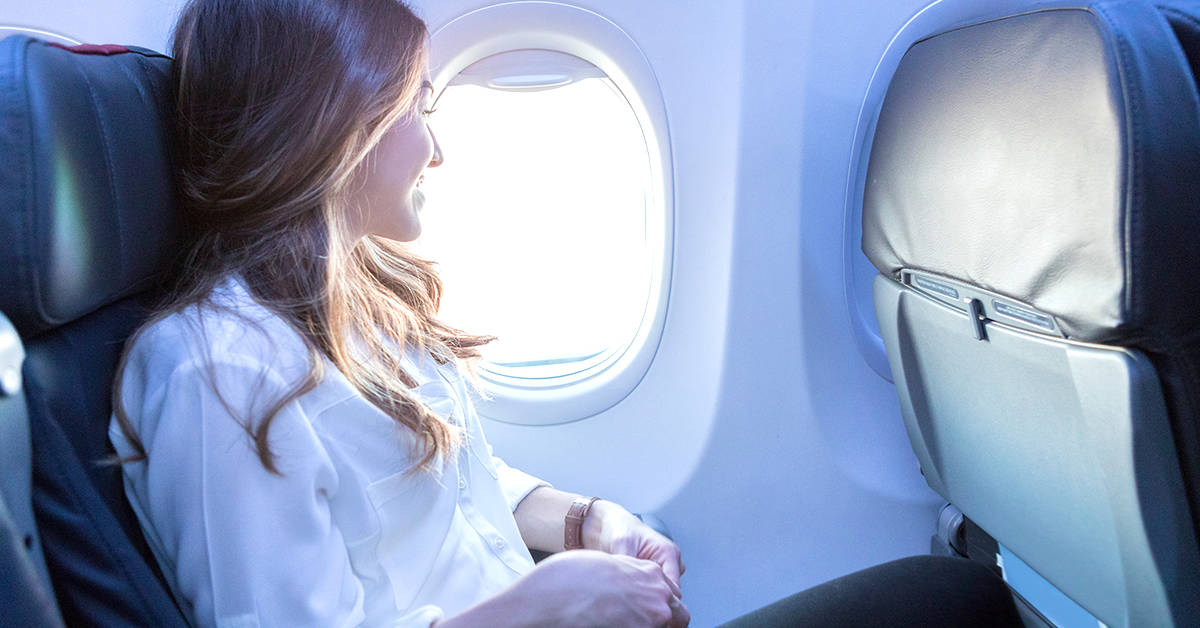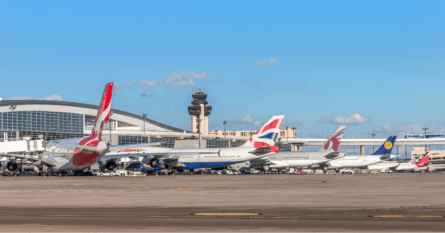Whether you’re traveling for work or for pleasure, it pays to be part of a frequent flyer program. In general, the best frequent flyer program for you depends on how often you fly and where you’re traveling to and from.

With tons of different frequent flyer programs and frequent flyer credit cards to choose from, it can be hard to know where to start. Here’s a rundown of what frequent flyer programs are, how to get one, and how to get the most out of it.
What is a frequent flyer program?
Frequent flyer programs are loyalty programs created by airlines to reward their most loyal customers. That said, even if you’re not loyal to just one airline here’s some benefits to joining.
The goal of every program is to accumulate points, often referred to as miles, on the airline. Those points are often accumulated on a yearly basis, and when you get enough you’re awarded “Status,” an indication to both you and the airline that you’re a frequent flyer. That status comes in different tiers, and with different perks. The more points you have, the higher your tier of status will be and the better the perks will be that are associated with it.
What is a frequent flyer number?
A frequent flyer number is a membership number that is unique to you and identifies you to the airline. In some cases that number is actually
You can think of it sort of like a rewards card number. You’ll input your frequent flyer number whenever you book a flight with an airline, and the airline will use it to keep track of how much you’ve flown during the year and what perks you’re eligible for. You’ll get your own unique number when you sign up for a frequent flyer account with an airline.
How to get a frequent flyer number
Frequent flyer numbers are free and easy to get. In order to get one, simply go to the website for the airline you plan on flying and look for its loyalty program. Each airline calls it’s program something different, but they all have one and they all work in a similar way. When you sign up, you’ll need to provide your name and address. In the U.S, you’ll also be prompted to input your Known Traveler or Redress number, if you have one, which is a number the TSA will have given you if you applied for TSA Pre and were accepted. When you do that, all subsequent flights you book, which are connected to your frequent flyer number, will automatically have that number connected to them as well, so you’ll be able to get “TSA Pre” on your boarding pass.
How do you accumulate frequent flyer points?
The easiest way to accumulate frequent flyer points or miles is to fly. Each time you fly with an airline you’ll earn point (or miles), which will be connected to your account. You’ll actually earn these points in two separate places. The first is your “Elite Qualifying Miles” and the second Miles that are accumulated in your account to be used for future flights, thus the best frequent flyer program for you in one with an airline you use frequently.
The “Elite Qualifying Miles” might be referred to by another name depending on your airline, but will represent the number of miles you actually fly on the airline, these are the miles an airline uses to determine your level of “Status.” For instance, if your flight was 2000 miles, then you’ll earn 2000 “Elite Qualifying Miles.” These miles are only used to determine your status on an airline. In most cases, you’ll need to get to 25,000 miles over the course of a year (January-December) in order to reach the lowest level of status on an airline and you’ll need to spend a certain amount of money on those tickets, usually around $300.
You’ll also earn regular miles or points each time you fly. These are the miles you can use to pay for future flights or things like Wi-Fi on board. How many miles you earn for a flight can vary pretty wildly. For example, booking a nicer seat on a place is often worth more miles than booking one in
For instance, on American Airlines you can earn a 40 percent miles bonus if you have Gold status, its
When you sign up for a frequent flyer program you’re often entitled to miles from past flights. The time frame varies from airline to airline, but flights made within the last 30 days are almost always eligible. In some cases, airlines will give you credit for flights taken 90 days ago or longer.

What about the best frequent flyer credit cards?
By and large, the best frequent flyer credit card for you is going to be the one affiliated with the airline you fly the most. All of the major airlines have partnered with banks to create branded credit cards. When you have one, you’re often able to get a lot of the same perks as people who have reached a status with the airline. For instance, some credit cards might offer free checked bags or priority boarding.
Most airline-specific credit cards also allow the money you spend on them to count as money towards achieving frequent-flyer status. With Delta, for instance, money spent on its American Express card can be used to help you earn a waiver for your “Medallion Qualifying Dollars”, the amount of money you’ll need to spend with the airline in order to qualify for elite status. The cards also offer two miles for every Delta purchase and one mile for every other purchase on the card. Some versions of the card also offer access to Delta’s Sky Club for free or at a discount and offer upgrade priority for customers.
“Miles” you earn on credit cards are exclusively miles that can be used to purchase future flights. Those credit card miles won’t count toward earning elite status.
If you tend to fly with a number of airlines, then Chase’s Sapphire Reserve card is considered “the” card to have by travel gurus. This card earns customers 3 x points on travel and dining purchases and 1x points on everything else. The card offers a 300 USD annual travel credit for customers, access to 1,000+ airport lounges, and things like included lost luggage and travel accident insurance.
Points you earn with the card can be changed into miles on any airline of your choosing at a 1:1 ratio (that transfer is only good for purchases not qualifying status). If you choose to book with Chase, then the points are worth 50 percent more. For instance, 50,000 points
How to maximize your frequent flyer points
Frequent flyer points can be used to pay for future flights, similar to how you might use another currency. The amount of miles or points you’ll need to purchase a flight varies depending on the airline you’re flying with and when you want to go. In general, the
Just like booking with cash, it pays to book your flights early when you’re using miles.
Why do you want elite status?
Elite Status comes with a variety of perks, all meant to give frequent flyers a more pleasant experience when they fly.
On a basic level, the higher your status on an airline, the more miles you’ll be able to earn, which can be redeemed for future flights. Being an elite member also allows you to use the Priority line when you’re checking your bags, and waives the fees for checked bags in most cases.
Elite flyers are put in earlier boarding groups, so they’re sure to get their carry-on baggage on-board, and are also given things like free upgrades to a higher class of service (even First!) and coupons for free drinks on board.

What’s the best frequent flyer program?
The best frequent flyer program is almost always going to be with the airline that offers the flights you want when you want them.
Case in point, Alaska Airlines is currently accepted amongst most travel gurus as the best frequent flyer program. However, if you frequently fly to New York for work and Delta offers a direct flight and Alaska doesn’t, then Delta might be a better choice for you. So before you pick an airline to be loyal to, make sure it’s the one that offers routes you want to take to destinations you frequently travel to, and at a reasonable price. For instance, in that same situation, if a United flight has a stop-over but is a 200 USD round trip and the direct Alaska flight is 500 USD, then you might want to consider United. It all depends on where you live, how you like to fly, and where you’re going.
The “top” frequent flyer programs vary from year to year but JetBlue Airways, Southwest Airlines, Alaska Airlines, American Airlines, Delta Airlines, and United Airlines often feature quite high. The Points Guy does a solid job of explaining, in depth, the difference between elite programs on its site.
If your travels often take you internationally, then it’s worth it to look into what airlines are part of the same network.
For instance, Qantas is a partner of American Airlines. That means even though you’re on a Qantas plane and flying in Australia, you can earn miles and even status on American Airlines with those flights.
United is part of the Star Alliance, which is the largest network of airlines. The Star Alliance includes 26 international airlines including Air Canada, Lufthansa, Singapore Airlines, and Air New Zealand. If one of those tends to be who you fly with the most, then you may want to consider United for your domestic travel as well.
By in large, every international airline will be partnered in some way with a U.S. one. The key is figuring out which airline, and then using your frequent flyer number when you book with them. All of those airlines also have their own frequent flyer programs. So, if you only fly Lufthansa and never fly domestically, you may want to choose Lufthansa’s rewards program over United’s option.
No matter what frequent flyer program you choose, the key is using one. Just like it pays to book a Blacklane professional airport transfer service, it pays to book your flights using a frequent flyer service.



